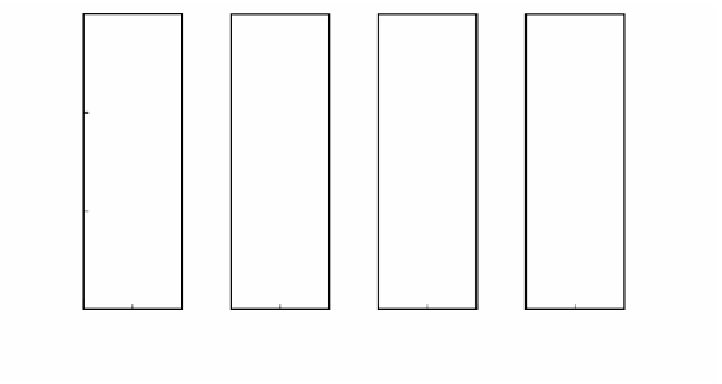Environmental Engineering Reference
In-Depth Information
300
2000
200
1800
1600
100
1400
1200
1000
0
0 0 00 0100
0
50
100
0
50
100
X mm
X mm
X mm
X mm
(a) Nozzle 1
(b) Nozzle 2
(c) Nozzle 3
(d) Nozzle 4
1860 K for nozzles 1 and 2, respectively. Relatively high temperatures appeared in
the downstream portion of the fuel jet for fuel nozzle 3, and its maximum was 1720
K. The lower half of the combustion chamber showed relatively low temperatures.
In spite of the same inlet air temperature and velocity, the maximum value was only
1690 K for fuel injection nozzle 4. Intense mixing seems to yield a more flattened
temperature distribution and lower maximum temperature. However, a much higher
temperature would have been generated if fuel had been burned with pure air.
Therefore, dilution of air with burned gases must have proceeded to some extent
before combustion.
Figure 2.57a
and b shows temperature fluctuations at the point of the highest
time-averaged temperature. In spite of the same temperatures and flow rates of fuel
and combustion air, both the time-averaged temperature distribution in the furnace
and the root-mean-square of fluctuations are lower for the case of fuel nozzle 4 than
for nozzle 2. The difference in emission index between the two cases is explained
by cumulative frequency distribution of fluctuating temperatures shown in
Figure
temperature is lower than 1800 K. The cumulative frequency corresponding to
1800 K reads almost 1.0 for nozzle 4, which means the temperature barely exceeds
1800 K. For nozzle 2, on the other hand, temperatures lower than 1800 K are 0.25,
which leads to a higher emission level of nitric oxides.
As previously mentioned, intense mixing of combustion air with burned gases
in the furnace, which is produced by high-momentum injection of combustion air,
lowers the flame temperature significantly and yields distributed reactions as shown
in the photograph on the cover of this topic. This combustion regime in low con-
centration of oxygen can be sustained only by the supply of highly preheated air. If
the temperature level of preheating is below the autoignition limit, the flame will
be extinguished instantly. Therefore, in addition to the use of highly preheated air,
the intense mixing of the air with sufficient burned gases before combustion is






Search WWH ::

Custom Search